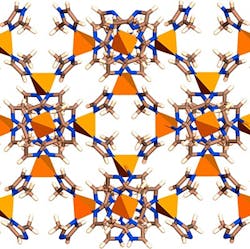New Option Beckons for Propylene Separation
Porous liquids (PLs) based on a metal organic framework (MOF) represent a breakthrough for separating propylene from other compounds, claim researchers at Karlsruhe Institute of Technology (KIT), Karlsruhe, Germany. Moreover, the approach promises to have far broader applicability, they say.
PLs are nanoparticles that typically float, finely distributed, in a solvent. Only molecules of a certain size can pass through their empty pores.
However, MOFs’ highly crystalline structure and lack of processability have limited their application in gas separation. The KIT workers have overcome these issues by using N-heterocyclic carbene ligands to functionalize the outer surface of a MOF called zeolitic imidazolate framework 67 (ZIF-67).
The team systematically modified the surface of ZIF-67 nanoparticles to vary the size of the pores from their original 0.34 nm and then finely dispersed the nanoparticles in liquids such as cyclohexane, cyclooctane and mesitylene.
So, for example, a gas with larger molecules such as propylene takes much longer to pass through a column filled with the PL than methane does.
“We want to exploit this property of the dispersion in the future to produce liquid separation membranes,” says Alexander Knebel of KIT’s Institute of Functional Interfaces.
Figure 1. In ZIF-67, methyl imidazolate (rods and rings) connect the metal centers of cobalt (pyramids) to each other. Source: R. Ahmad, KIT.
The researchers also managed to produce solid membranes by embedding the modified ZIF-67 (Figure 1) in a plastic material. Once the ZIF-67 content of the membrane reached 47.5%, they passed a mixture of propylene and propane over two membranes arranged in series — and obtained propylene with a purity exceeding 99.9% despite the barely 0.2-nm difference in size between the two molecules. The team reports their results in a recent issue of Nature Materials.
Knebel believes that a separation process such as this could replace energy-intensive distillation commonly used now.
“Our selling point is the processability. And, of course it is scalable; nanoparticles can be made and hollow fiber membranes can be spun. We have a patent filed and are looking for industrial partners to scale it up with,” he notes.
All small-pore MOFs should be processable in a similar way to form PLs and the approach can be extended to other MOFs and applications, he reckons.
Knebel has spoken with BASF’s start-up funding agencies — who showed a major interest in the research — and also is looking to get other parties involved.

